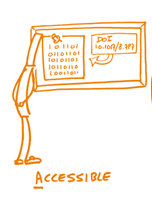FAIR principles
The FAIR principles, launched in 2014, aim to improve discovery, access, integration and usability of data, both by machines and by human beings.
FAIR stands for:
- Findable
- Accessible
- Interoperable
- Reusable
Each letter representing a category of principles. These 4 categories encompass a set of 14 principles.
To sum up the 14 principles:
 |
 |
 |
 |
|
|
|
|
|
If the dataset cannot be made openly accessible to all, at least its description should be publicly accessible online. |
In a repository that ensures long-term preservation |
To be compatible and combinable with other datasets |
So data can be correctly interpreted and reused |
Image by Patrick Hochstenbach CC0: https://book.fosteropenscience.eu/
Why is it important?
These principles are often mentioned by funding agencies, institutions (including the University of Geneva) or publishers, who recommend their adoption. The more FAIR a dataset is, the easier it will be to identify, access, understand and reuse it. By following the FAIR principles, you enrich your research data.
How do I know if my data is FAIR compliant?
There are tools to help you do a self-diagnosis and identify possible areas for improvement.
We recommend in particular the use of the self-diagnosis tool proposed by the Australian Research Data Commons
FAIR = Open ?
Not necessarily.
- Open data may or may not comply with the FAIR principles. It all depends if the about principles are followed or not.
- On the other hand, data that is closed and/or can be shared on demand may be FAIR compliant.
